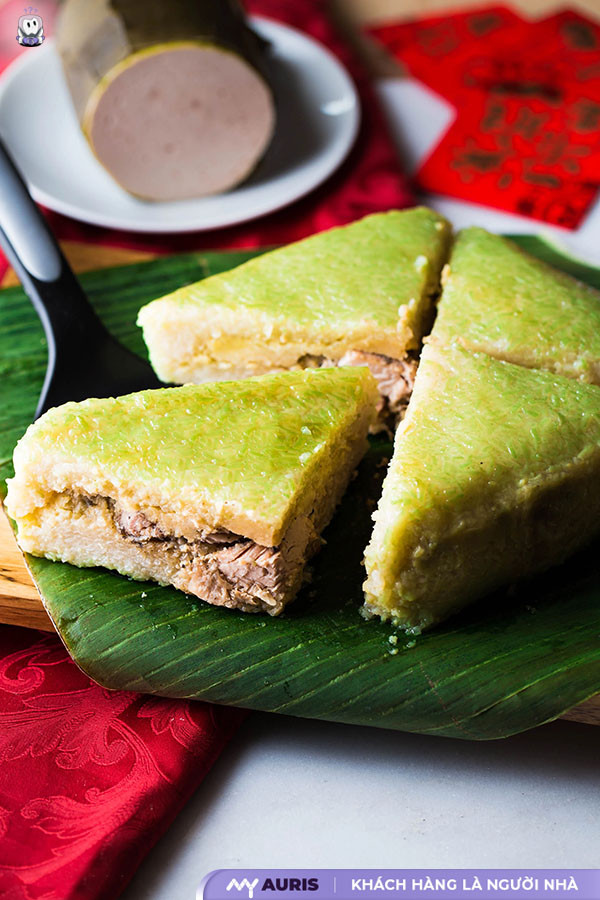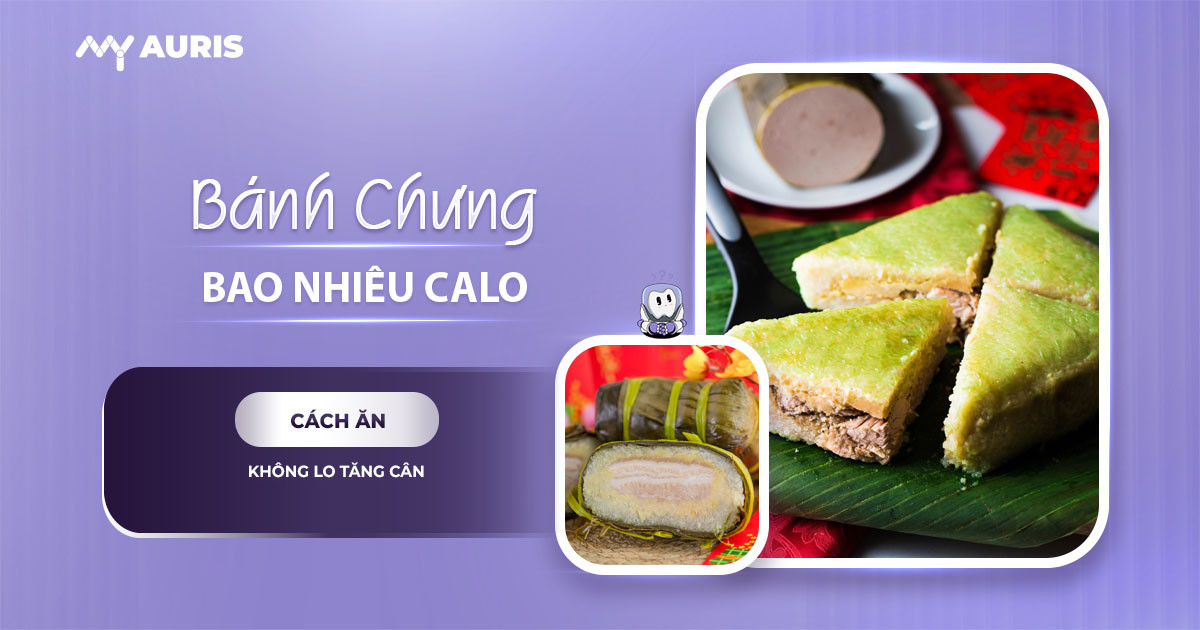This traditional Banh Chung dish contains a significant amount of energy, especially for those concerned about diet and weight. Understanding the nutritional composition of Banh Chung will help you make reasonable choices for your Tet holiday menu. In the article below, My Auris Dental Clinic will guide you on how to properly eat and preserve Banh Chung to limit weight gain and avoid affecting your health.
How Many Calories in One Banh Chung?
A medium-sized Banh Chung (approximately 600–700g) provides 700 to 900 kcal, depending on the proportion of fatty pork and glutinous rice used. On average:
- 100g of boiled Banh Chung contains about 160–200 kcal
- 100g of fried Banh Chung provides about 250–300 kcal, 50–100 kcal higher than boiled Banh Chung. If you consume about 300g of fried Banh Chung in one sitting, you could take in nearly 900 kcal from just one dish.
Vietnamese Food Calorie Table
| Type | Calorie Content |
| 100g boiled Banh Chung | 160–200 kcal |
| 1 whole Banh Chung (600–700g) | 700–900 kcal |
| 100g fried Banh Chung | 250–300 kcal |
Compared to other Tet dishes like Gac sticky rice (xôi gấc), pork sausage (giò lụa), or Banh Tet, Banh Chung has a similar or higher calorie content, especially if it contains a lot of fatty pork. Therefore, eating one Banh Chung every day during Tet can easily lead to excessive energy intake, causing abdominal fat accumulation, especially if you are not very active or don’t exercise.

What’s Special About the Nutritional Content of Banh Chung?
Below is the nutritional composition table for 100g of Banh Chung (boiled, traditional, with fatty pork and mung bean filling):
| Component | Content per 100g | Notes |
| Energy (calories) | 160–200 kcal | Depending on the proportion of fatty pork, glutinous rice, mung beans |
| Protein | 4–6 g | From mung beans and pork |
| Fat | 4–8 g | Mainly from fatty pork |
| Carbohydrates (starch) | 25–30 g | From glutinous rice |
| Fiber | ~1 g | Present in mung beans and dong leaves |
| Sugar | No sugar added | |
| Sodium (salt) | 200–300 mg | Depending on the amount of salt used to season the filling |
| Calcium | ~10 mg | Negligible amount |
| Iron | ~0.5 mg | From pork and mung beans |
| Cholesterol | 10–25 mg | Present in fatty pork |
| Water | 30–35 g | Banh Chung has high moisture content after boiling |
Does Eating Banh Chung Cause Weight Gain?
On average, a Banh Chung weighing about 1kg can contain 1,500 to 1,800 calories. If you divide it into 8 portions, each slice is equivalent to 200 to 230 calories. This is a fairly high energy level compared to typical daily meals, especially when consumed with pork sausage (giò lụa), Gac sticky rice (xôi gấc), or fried foods.
Banh Chung is made from glutinous rice – a fast-absorbing starch that can easily raise blood sugar. The filling consists of mung beans, rich in resistant starch, and fatty pork, which contains many saturated fats. If eaten excessively and frequently, you can easily exceed your daily caloric needs, leading to the accumulation of excess fat.
However, whether eating Banh Chung causes weight gain depends on how and how much you eat. An adult needs approximately 2,000 calories per day. If you eat one slice of Banh Chung and stay within your allowed energy limit, it will not cause weight gain.

How to Eat Banh Chung Without Worrying About Weight Gain
If you know how to eat it properly, you can fully enjoy Banh Chung without worrying about your weight. Here are some simple ways to effectively control calories:
- Cut Banh Chung into appropriate portions
Do not eat the whole cake at once. An ideal portion is 1/8 to 1/6 of a Banh Chung, equivalent to 100–150g. The calorie content in this portion ranges from approximately 160–250 kcal, comparable to a snack.
- Avoid eating Banh Chung in the evening
Banh Chung is rich in starch and fat. Eating it in the evening can easily cause bloating, indigestion, and accumulation of excess fat. Prioritize eating it for breakfast or lunch, combined with light physical activity after your meal.
- Do not fry Banh Chung
Frying Banh Chung doubles its calorie content due to oil absorption. If you want to eat it warm, you can steam it or pan-fry it without oil to reduce excess calories.
- Serve with green vegetables and pickled dishes
Vegetables help increase fiber, aid digestion, and slow down the absorption of sugar and fat. This is an effective way to balance nutrition in a meal that includes Banh Chung.
- Do not eat Banh Chung with other high-calorie dishes at the same time
Avoid combining Banh Chung with sticky rice, pork head cheese, or braised pork with eggs in the same meal. Instead, choose Banh Chung as the main dish, and the other dishes should be light, such as vegetable soup, bean sprouts, or fresh vegetables.

Comparing Banh Chung Calorie Content with Other Tet Dishes
For easier visualization, below is a comparison table of the calorie content of some common dishes in the Tet holiday feast:
| Traditional Dish | Estimated Calorie Content (average) |
| Banh Chung | 700–800 kcal / cake |
| Banh Tet | 750–850 kcal / small log |
| Pork sausage (Gio Lua) | 250–300 kcal / 100g |
| Gac sticky rice (Xoi Gac) | 350–400 kcal / small plate |
| Banh Giay | 200–250 kcal / cake |
| Banh U | 250–300 kcal / cake |
Looking at the table, it’s clear that Banh Chung and Banh Tet are the two dishes with the highest calorie content. Both are made from glutinous rice, but Banh Tet often contains more meat and is wrapped in a cylindrical shape, so its weight can be greater. Gio Lua, though high in protein, contains less starch, resulting in a significantly lower calorie count. Xoi Gac is also rich in starch and fat, but it’s usually eaten as a side dish, so the consumed amount is smaller.
Proper Storage and Use of Banh Chung
Banh Chung is wrapped in dong leaves, filled with fatty pork and mung beans, and cooked by long boiling (from 8 to 12 hours). This creates an environment prone to moisture and fermentation if left at room temperature for too long. During the humid Tet weather, the cake can easily become moldy or grow bacteria, affecting digestion, causing bloating, and even stomach aches if spoiled parts are consumed. Here are safe and simple ways to preserve Banh Chung:
Cool Banh Chung after cooking or receiving it: Do not put the cake in the refrigerator while it’s still hot, as this makes it prone to condensation, leading to quick molding. Place the cake in a cool, clean, and well-ventilated area for the first few hours.
Portion the cake if not eating it all within a few days: Use a clean knife to cut the cake into smaller pieces, wrapping each piece with plastic wrap or a zip-lock bag. Portioning helps avoid opening it multiple times, limiting air exposure which can spoil the cake quickly.
Store according to usage time: If eating within 1-2 days: keep it in the refrigerator’s cool compartment, at 4-6 degrees C. If storing for longer than 3-7 days: it should be frozen in the freezer. Before eating, thaw naturally or re-steam to maintain its flavor.
Do not leave Banh Chung outside for more than 24 hours if the weather is hot or humid: If the cake shows signs of becoming soft, watery, moldy, or has an unusual smell, it should no longer be consumed.
Banh Chung is not just a traditional dish, but also embodies Vietnamese culinary cultural value. However, for this dish to bring complete joy, you need to know how to store it hygienically and consume it reasonably. Proactively portioning the cake, properly refrigerating it, and controlling your serving sizes will help you avoid weight gain after Tet, while also limiting digestive and health risks.





